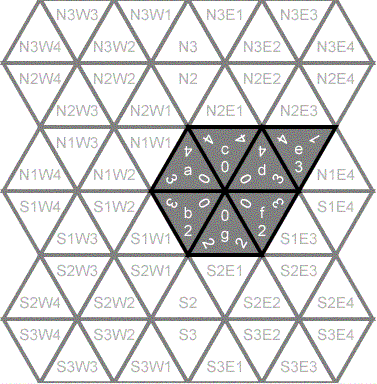
|
| Fig. 1: Triominos board layout. N1 is the location for the first play. Grey triangles are considered "upward" and white triangles are considered "downward". |

|
| Fig. 2: Board after seven legal plays. Note that all pieces have adjacent edges and matching values on vertices. The turn of the play is written as 'a', 'b', 'c', ..., 'g' on the center of the piece. |
The game of triominos is played on a board of infinite extent which follows the pattern shown in figure 1. There are 76 triangular play pieces with a digit on each vertex. The digits are in the range 0 through 5 with possible repetition on a given game piece. The 76 pieces represent all possible vertex labels up to a rotation of the piece.
Some example pieces, reading the vertex values clockwise would be "000", "010" and "025". Note, however, that "250" and "502" are simply rotations of the single piece "025". This means that "250" and "502" cannot both be played in the same game: they are the same piece.
Play proceeds as follows: The first piece is drawn at random and placed on the board at location "N1." After this, play proceeds in turns. Each player places a piece so that:
(1) The piece has at least one edge adjacent to the edge of another piece already on the board.
(2) The piece matches all vertex values of adjacent vertices.
The point of this problem is, given a sequence of plays, you are to determine if they represent valid plays of the game in three respects:
(1) The placement of pieces follows the above rules.
(2) No piece is used more than once
(3) No space is occupied more than once.